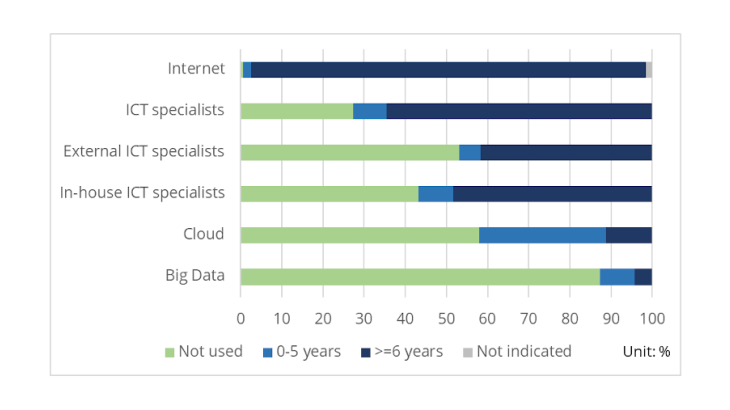Key: 58% of firms do not use the cloud at all, 31% have used it for less than 5 years and 11% have used it for more than 5 years.
Over the last decades, productivity growth has declined in most developed countries, regardless of their distance to the technological frontier. If this trend were to continue, such low productivity gains would make it very difficult to tackle the serious headwinds we currently face: population ageing, the sustainability of our healthcare systems, rising inequalities, environmental risks or the increase in public debt.
Digitalisation is often seen as the potential source of a huge and possibly long productivity revival that would enable us to address these challenges. However, paradoxically, this productivity revival induced by digitalisation is taking a long time to make itself felt. According to Van Ark (2016), “the New Digital Economy is still in its ‘installation phase’ and productivity effects may only occur once the technology enters the ‘deployment phase’”.
National strategies of repeated lockdowns will clearly foster greater digitalisation among firms. By way of example, according to the November Survey of SME Cash Levels, Investment and Growth (Bpifrance Rexecode), 50% of business leaders questioned about their medium-term strategy “indicated that they had begun steps to digitalise their company, focusing first on the organisation of their relationships with customers, and 20% planned to take such steps in the short to medium term but had not yet done so.” But what do we know about French firms’ use of digital technologies? How can it be expected to impact productivity?
Use of digital technologies can mainly be observed among the largest firms
The Banque de France carries out an annual survey of manufacturing firms with at least 20 employees, in order to collect information on their use of production factors. As part of each survey, it also gathers information on specific topics of interest. In 2018, firms were asked whether they used the internet (since when and with what type of internet connection), and whether they employed Information and Communication Technology (ICT) specialists (external or in-house) or used digital technologies (cloud and big data). To the best of our knowledge, this Banque de France survey, alongside INSEE’s ICT survey, is one of the few sources of data on firms’ use of digital technology in France.
The results of this survey show that use of digital technologies is:
- still fairly limited (Chart 1): while the majority of the 1,065 firms surveyed said they used the internet, and 65% said they had employed ICT specialists (external or in-house) for 5 years or more, only 42% said they used the cloud (nearly a third for less than 5 years). In addition, 13% said they carried out big data analyses and had generally done so for less than 5 years.
- highly concentrated among the largest firms (Chart 2): the use of ICT staff and digital technologies tends to increase with the size of the firm. While only 28% of firms with between 20 and 49 employees use the cloud, this rises to 70% for firms with between 250 and 499 employees. In the case of big data, nearly 40% of firms with at least 500 employees said they used it, while the figure was just 10% for SMEs. The existence of a positive correlation between firm size and demand for ICT is also documented extensively by Lashkari et al. (2019) with regard to French firms’ investment in IT hardware and software.

